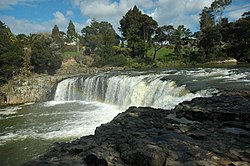Haruru, New Zealand
Locality in New Zealand From Wikipedia, the free encyclopedia
Locality in New Zealand From Wikipedia, the free encyclopedia
Haruru is a residential and commercial locality in the Far North District of New Zealand. State Highway 11 runs through the locality. Puketona is 10 kilometres west, and Paihia is 4 kilometres east, The name means a continuous noise or roar in the Māori language,[3] which refers to the sound of Haruru Falls, a five metre high broad waterfall about a kilometre away.[4]
Haruru | |
|---|---|
 Haruru Falls | |
 | |
| Coordinates: 35.281°S 174.058°E | |
| Country | New Zealand |
| Region | Northland Region |
| District | Far North District |
| Ward | Bay of Islands-Whangaroa |
| Community | Bay of Islands-Whangaroa |
| Subdivision | Paihia |
| Electorates | |
| Government | |
| • Territorial Authority | Far North District Council |
| • Regional council | Northland Regional Council |
| Area | |
| • Total | 1.53 km2 (0.59 sq mi) |
| Population (June 2024)[2] | |
| • Total | 1,230 |
| • Density | 800/km2 (2,100/sq mi) |
The pool at the base of the falls was an early river port for Northland, with the Waitangi River providing access to the Bay of Islands. A hotel was built at Haruru in 1828, and a store was added to it about 1858.[5] The hotel burned down in 1937. It may have been the first licensed hotel in New Zealand.[6]
Haruru covers 1.53 km2 (0.59 sq mi)[1] and had an estimated population of 1,230 as of June 2024,[7] with a population density of 804 people per km2.
| Year | Pop. | ±% p.a. |
|---|---|---|
| 2006 | 786 | — |
| 2013 | 867 | +1.41% |
| 2018 | 1,077 | +4.43% |
| Source: [8] | ||
Haruru had a population of 1,077 at the 2018 New Zealand census, an increase of 210 people (24.2%) since the 2013 census, and an increase of 291 people (37.0%) since the 2006 census. There were 393 households, comprising 528 males and 546 females, giving a sex ratio of 0.97 males per female. The median age was 45.0 years (compared with 37.4 years nationally), with 213 people (19.8%) aged under 15 years, 129 (12.0%) aged 15 to 29, 489 (45.4%) aged 30 to 64, and 243 (22.6%) aged 65 or older.
Ethnicities were 79.1% European/Pākehā, 25.9% Māori, 4.5% Pacific peoples, 3.9% Asian, and 2.5% other ethnicities. People may identify with more than one ethnicity.
The percentage of people born overseas was 25.9, compared with 27.1% nationally.
Although some people chose not to answer the census's question about religious affiliation, 51.5% had no religion, 37.0% were Christian, 3.3% had Māori religious beliefs, 0.6% were Hindu, 0.3% were Muslim, 0.6% were Buddhist and 1.4% had other religions.
Of those at least 15 years old, 132 (15.3%) people had a bachelor's or higher degree, and 150 (17.4%) people had no formal qualifications. The median income was $25,000, compared with $31,800 nationally. 78 people (9.0%) earned over $70,000 compared to 17.2% nationally. The employment status of those at least 15 was that 378 (43.8%) people were employed full-time, 126 (14.6%) were part-time, and 30 (3.5%) were unemployed.[8]
Seamless Wikipedia browsing. On steroids.
Every time you click a link to Wikipedia, Wiktionary or Wikiquote in your browser's search results, it will show the modern Wikiwand interface.
Wikiwand extension is a five stars, simple, with minimum permission required to keep your browsing private, safe and transparent.